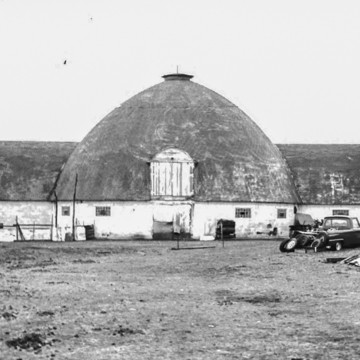The Cote family immigrated to Rolette County from eastern Canada sometime during the first decades of the twentieth century. The family’s French Canadian background is typical of many of the county’s residents. Cote and his father were carpenters who specialized in the construction of barns in the years before World War II. The Cotes purchased the farm in 1943 and constructed the round barn that same year. The barn stands in almost its original condition. Concrete block forms the foundation and wall to the mow level. The mow is enclosed by the roofing system of rafters. The roof is hemispherical in shape and is covered with cedar shingles. Pointed-arch roofs enclose two wings and small dormers puncture the main roof on the north and south. The Cote barn is significant for its craftsmanship, its shape, and because it was constructed for two different purposes. The first floor housed cattle, while the upper mow was designed to accommodate dances as well as hay. The barn was even used for roller skating in the 1950s. Framing the roof of this round barn was clearly the greatest technical challenges for its builders. The Cotes apparently modeled their barn after the round Glick barn (c. 1939; demolished) in Surrey, one hundred miles to the southwest. The forty-five-foot-long rafters were cut to a specific inner diameter as opposed to the more common method of bending or laminating. The builders’ pride in this achievement reportedly led them to shingle the roof with eight different colors of shingles that were later replaced with cedar shingles.
You are here
Urbain Cote Round Barn
If SAH Archipedia has been useful to you, please consider supporting it.
SAH Archipedia tells the story of the United States through its buildings, landscapes, and cities. This freely available resource empowers the public with authoritative knowledge that deepens their understanding and appreciation of the built environment. But the Society of Architectural Historians, which created SAH Archipedia with University of Virginia Press, needs your support to maintain the high-caliber research, writing, photography, cartography, editing, design, and programming that make SAH Archipedia a trusted online resource available to all who value the history of place, heritage tourism, and learning.















